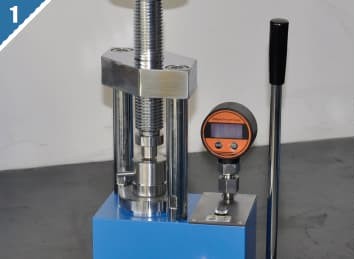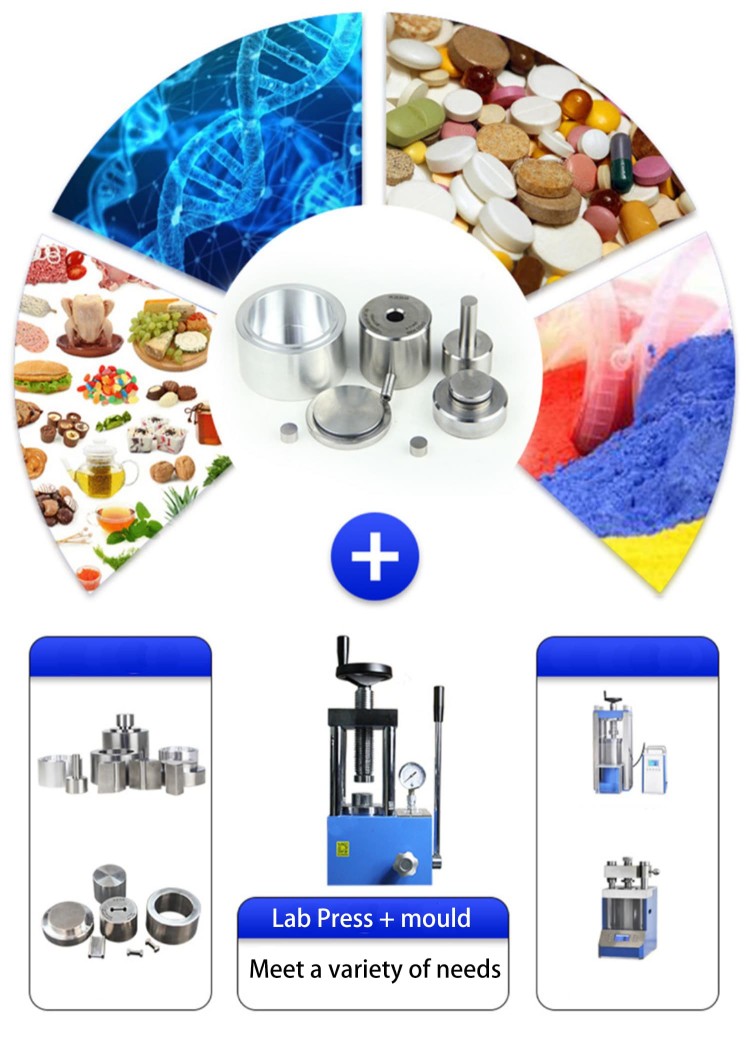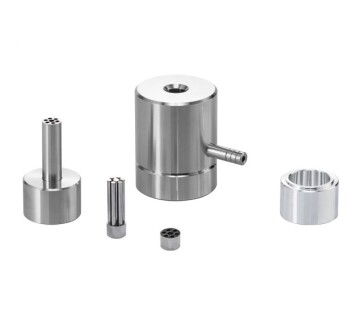
Molds & Accessories
Carbide Lab Press Mold for Laboratory Applications
Item Number : PMW
Price varies based on specs and customizations
- Material
- Carbide YT15
- Indenter hardness
- HRC85-HRC90
- Cavity depth
- 30-50 mm
Shipping:
Contact us to get shipping details Enjoy On-time Dispatch Guarantee.
Why Choose Us
Easy ordering process, quality products, and dedicated support for your business success.
Applications
Carbide Lab Press mold is suitable for forming samples with ultra-high powder hardness.
The mold is widely used in battery, superconductor, cement, ceramics, catalysis, silicate, powder metallurgy, sea mud analysis, biochemical analysis and new material sample preparation research and development. In addition, the product can also be used with calcium iron, infrared, X-ray fluorescence and other testing instruments.
The mold is made of Japanese high-speed steel, high hardness, no deformation, long service life.
Special sizes press molds can be customized according to customer requirements.
Detail & Parts
![Carbide mold [Φ3-10mm]](https://image.kindle-tech.com/images/products/120/703a26f99b0d751d261782ddf3f49a5867bc260e9d95f.jpg)
![Carbide mold [Φ11-20mm]](https://image.kindle-tech.com/images/products/120/05233ac87e4e6c003e4e145d6ed1c9b367bc26390e749.jpg)
![Carbide mold [Φ21-30mm]](https://image.kindle-tech.com/images/products/120/0191442eef868550cd21e2257451c69167bc266073b38.jpg)

Technical specifications
| Model | PMW-A | PMW-B | PMW-C | ||||
|---|---|---|---|---|---|---|---|
| Material | Carbide YT15 | ||||||
| Indenter hardness | HRC85-HRC90 | ||||||
| Sample size | φ3 /φ4 /φ5 /φ6 /φ8 /φ10 mm | φ12 /φ13 /φ15 /φ18 /φ20 mm | φ22 /φ25 /φ28 /φ30 mm | ||||
| Cavity depth | 30 mm | 40 mm | 45 mm | ||||
| External dimensions | φ43×93 mm | φ53×120 mm | φ73×133 mm | ||||
| Weight(Kg) | 0.78 | 1.8 | 3.8 | ||||
| Other sizes can be customized | |||||||
Operation steps
The cemented carbide mold is designed for creating samples with ultra-high powder hardness. This mold can produce tablets with diameters ranging from 8 to 40mm, and can also be customized according to specific customer requirements.

Step 1: Assemble the die according to the operation diagram and install the sample in the cavity.

Step 2: Put the die in the center of the hydraulic press and pressurize to required pressure.

Step 3: Assemble the die according to the release diagram , eject the sample out of the die bushing with the screw rod.

Step 4: Take out the die from the hydraulic press , and remove the sample gently.
Precautions for mold maintenance
To ensure accurate test results, clean the mold surface with dust-free paper before each use to avoid the anti-rust oil from affecting the sample. Avoid exceeding the maximum pressure when applying pressure. Clean the mold and samples after use to prevent corrosion. Apply anti-rust oil and store the mold in a dry environment if not used for a long time to prevent damage.

Step 1: Placing the Mold.
To begin, place the mold in the center of the tablet press. It is important to note that the maximum pressure of the mold cannot be exceeded when pressurized. This will prevent any damage to the mold and ensure accurate test results.

Step 2: Cleaning the Mold.
After each use, it is essential to clean the mold to prevent any contamination of the sample. Using dust-free paper, wipe the surface of the mold clean. If there are sample residues on the surface that cannot be removed, please do not use chemical reagents to clean and soak. This could potentially damage the mold and impact the accuracy of the test results.

Step 3: Applying Anti-Rust Oil.
If the mold is not used for an extended period, it is recommended to apply anti-rust oil on the surface of the mold to prevent rusting. This step will help prolong the life of the mold and ensure that it remains in good condition for future use.

Step 4: Storing the Mold.
Lastly, if the mold is not used for a long time, it needs to be stored in a dry environment. This will prevent any moisture from accumulating on the mold and causing damage.
Full range of lab press types

Click to view our full range of lab press products.
Any question? Our experts have helped many laboratories choose their lab press, contact us now!
Full range of types of laboratory press molds
We have a full range of molds for you to choose from, and the molds fit the body perfectly.
If you need molds with special shapes, we can also customize them for you.

Warnings
Operator safety is the top important issue! Please operate the equipment with cautions. Working with inflammable& explosive or toxic gases is very dangerous, operators must take all necessary precautions before starting the equipment. Working with positive pressure inside the reactors or chambers is dangerous, operator must fellow the safety procedures strictly. Extra caution must also be taken when operating with air-reactive materials, especially under vacuum. A leak can draw air into the apparatus and cause a violent reaction to occur.
Designed for You
KinTek provide deep custom made service and equipment to worldwide customers, our specialized teamwork and rich experienced engineers are capable to undertake the custom tailoring hardware and software equipment requirements, and help our customer to build up the exclusive and personalized equipment and solution!
Would you please drop your ideas to us, our engineers are ready for you now!
FAQ
What Is A Press Mold?
What Is Press Mould In Ceramics?
How Are Pellet Molds Used?
What Types Of Materials Can Be Pelletized Using Pellet Molds?
How Can One Select The Appropriate Pellet Mold For Their Specific Application?
4.9 / 5
I'm so impressed with the quality and durability of this press mold. It's made of high-speed steel and has a hardness of HRC85-HRC90, which means it can withstand high pressures and temperatures.
4.8 / 5
This press mold is a game-changer for our lab. It allows us to produce tablets with diameters ranging from 8 to 40mm, and it can be customized to meet our specific requirements. The sample preparation and demolding process is also very easy.
4.7 / 5
I'm very happy with the Carbide Lab Press Mold. It's made of high-quality materials and it's very easy to use. I would definitely recommend it to other labs.
4.9 / 5
This press mold is a great value for the money. It's made of durable materials and it's very easy to use. I've been using it for several months now and I've had no problems with it.
4.8 / 5
I'm very impressed with the speed of delivery for this press mold. I ordered it online and it arrived within two days. I was also impressed with the quality of the product. It's made of high-quality materials and it's very well-made.
4.7 / 5
I'm very happy with the Carbide Lab Press Mold. It's a great value for the money and it's very easy to use. I would definitely recommend it to other labs.
4.9 / 5
This press mold is a great addition to our lab. It's very easy to use and it produces high-quality samples. I would definitely recommend it to other labs.
4.8 / 5
I'm very impressed with the durability of this press mold. I've been using it for several months now and it's still in perfect condition. I would definitely recommend it to other labs.
4.7 / 5
I'm very happy with the Carbide Lab Press Mold. It's a great value for the money and it's very easy to use. I would definitely recommend it to other labs.
4.9 / 5
This press mold is a great addition to our lab. It's very easy to use and it produces high-quality samples. I would definitely recommend it to other labs.
4.8 / 5
I'm very impressed with the speed of delivery for this press mold. I ordered it online and it arrived within two days. I was also impressed with the quality of the product. It's made of high-quality materials and it's very well-made.
4.7 / 5
I'm very happy with the Carbide Lab Press Mold. It's a great value for the money and it's very easy to use. I would definitely recommend it to other labs.
4.9 / 5
This press mold is a great addition to our lab. It's very easy to use and it produces high-quality samples. I would definitely recommend it to other labs.
4.8 / 5
I'm very impressed with the durability of this press mold. I've been using it for several months now and it's still in perfect condition. I would definitely recommend it to other labs.
4.7 / 5
I'm very happy with the Carbide Lab Press Mold. It's a great value for the money and it's very easy to use. I would definitely recommend it to other labs.
4.9 / 5
This press mold is a great addition to our lab. It's very easy to use and it produces high-quality samples. I would definitely recommend it to other labs.
4.8 / 5
I'm very impressed with the speed of delivery for this press mold. I ordered it online and it arrived within two days. I was also impressed with the quality of the product. It's made of high-quality materials and it's very well-made.
REQUEST A QUOTE
Our professional team will reply to you within one business day. Please feel free to contact us!
Related Products

Cylindrical Press Mold for Lab Applications
Efficiently form and test most samples with Cylindrical Press Molds in a range of sizes. Made of Japanese high-speed steel, with long service life and customizable sizes.

Round Bidirectional Press Mold for Lab
The round bidirectional press mold is a specialized tool used in high-pressure molding processes, particularly for creating intricate shapes from metal powders.

Anti-Cracking Press Mold for Lab Use
The anti-cracking press mold is a specialized equipment designed for molding various shapes and sizes of film using high pressure and electric heating.

Special Shape Press Mold for Lab
Discover high-pressure special shape press molds for diverse applications, from ceramics to automotive parts. Ideal for precise, efficient molding of various shapes and sizes.

Assemble Lab Cylindrical Press Mold
Get reliable and precise molding with Assemble Lab Cylindrical Press Mold. Perfect for ultra-fine powder or delicate samples, widely used in material research and development.

Special Heat Press Mold for Lab Use
Square, round and flat plate forming dies for hot presses.

Ball Press Mold for Lab
Explore versatile Hydraulic Hot Press molds for precise compression molding. Ideal for creating various shapes and sizes with uniform stability.

No Demolding Lab Infrared Press Mold for Laboratory Applications
Effortlessly test your samples with no demolding required using our lab infrared press mold. Enjoy high transmittance and customizable sizes for your convenience.

kbr pellet press 2t
Introducing the KINTEK KBR Press - a handheld laboratory hydraulic press designed for entry-level users.

Laboratory Hydraulic Press Lab Pellet Press Machine for Glove Box
Controlled environment lab press machine for glove box. Specialized equipment for material pressing and shaping with high precision digital pressure gauge.

Multi-Punch Rotary Tablet Press Mold Ring for Rotating Oval and Square Molds
The multi-punch rotary tablet press mold stands as a pivotal component in pharmaceutical and manufacturing industries, revolutionizing the process of tablet production. This intricate mold system comprises multiple punches and dies arranged in a circular fashion, facilitating rapid and efficient tablet formation.

Infrared Heating Quantitative Flat Plate Press Mold
Discover advanced infrared heating solutions with high-density insulation and precise PID control for uniform thermal performance in various applications.

Heated Hydraulic Press Machine with Heated Plates Split Manual Laboratory Hot Press
Efficiently prepare your samples with our Split Manual Heated Lab Press. With a pressure range up to 40T and heating plates up to 300°C, it's perfect for various industries.

Stainless Steel Laboratory Ball Mill for Dry Powder and Liquid with Ceramic Polyurethane Lining
Discover the versatile stainless steel dry powder/liquid horizontal ball mill with ceramic/polyurethane lining. Ideal for ceramic, chemical, metallurgical, and building materials industries. High grinding efficiency and uniform particle size.
Related Articles

Ceramic Isostatic Pressing Mold Technology
Exploring the design and factors affecting ceramic isostatic pressing molds.

Pressing Powder Samples and Molding Polymer Films: A Comprehensive Guide
Pressing powder samples is done to create a solid material that remains intact even after the load is removed. This process involves pushing the powder grains closer together, closing the gaps between them and forcing them to flow and rearrange themselves into a more compact arrangement. As the available volume reduces, the flow of particles stops, and they undergo plastic and elastic deformations that result in bonding between the grains.

Comprehensive Guide to Isostatic Pressing Molds: Types, Processes, and Applications
Explore the detailed world of isostatic pressing molds, including types like wet bag and dry bag, their processes, and applications. Learn how these molds ensure uniform density and high-strength products.

CIP vs. Metal Mold Pressing What's the Difference
CIP and Metal Mold Pressing are used to create high-density components, but they differ in terms of the level of complexity required and the final outcome. Understanding these differences can help manufacturers determine which method is best suited for their needs.

Operating of Automatic Lab xrf Pellet Press
How to use the Automatic Lab xrf Pellet Press, including steel ring, plastic ring, boric acid mold

Isostatic Presses vs Other Powder Compaction Methods
Powder compaction is a process used to form solid objects from powder. The process involves compressing the powder into a die, where it is subjected to high pressure to form a solid object.

The Benchtop KBr Pellet Press: An Efficient Tool for Laboratory Use
The benchtop KBr pellet press is a versatile and efficient tool that produces uniform pellets, ensuring consistent and reliable results. In addition, its adjustable mold can be used flexibly to accommodate a variety of sample sizes and shapes.

How To Turn XRF analysis sample preparation Into Success
In X-ray fluorescence (XRF) analysis, sample preparation is an important step because it can significantly impact both the quality and the efficiency of the analysis.

Infrared Press Mold Techniques for Non-Demolding Applications
Explore advanced infrared press mold techniques without demolding. Learn about the benefits, applications, and best practices for non-demolding lab processes.

Understanding the Importance and Applications of Laboratory Presses
Laboratory presses play a vital role in various industries, providing precision and consistency in demanding operations. These versatile machines are used for testing, compacting, and molding materials in sectors such as pharmaceutical, laminating, rubber, and plastic molding. Whether it's for R&D, limited production, or lean manufacturing, laboratory presses offer durability and rigorous demand fulfillment.

Comprehensive Guide to Cylindrical Lab Electric Heating Press Mold: Technology and Applications
Explore the advanced features and applications of cylindrical lab electric heating press molds. Learn about their working principles, types of heating technologies, and key benefits for precise sample preparation.

The Effect of Powder Moisture Content on Cold Isostatic Pressing
Cold Isostatic Pressing (CIP) is a manufacturing process used to create high-density ceramics and metals. This process involves placing the powder into a flexible mold, which is then pressurized with a liquid medium to create a uniform density.